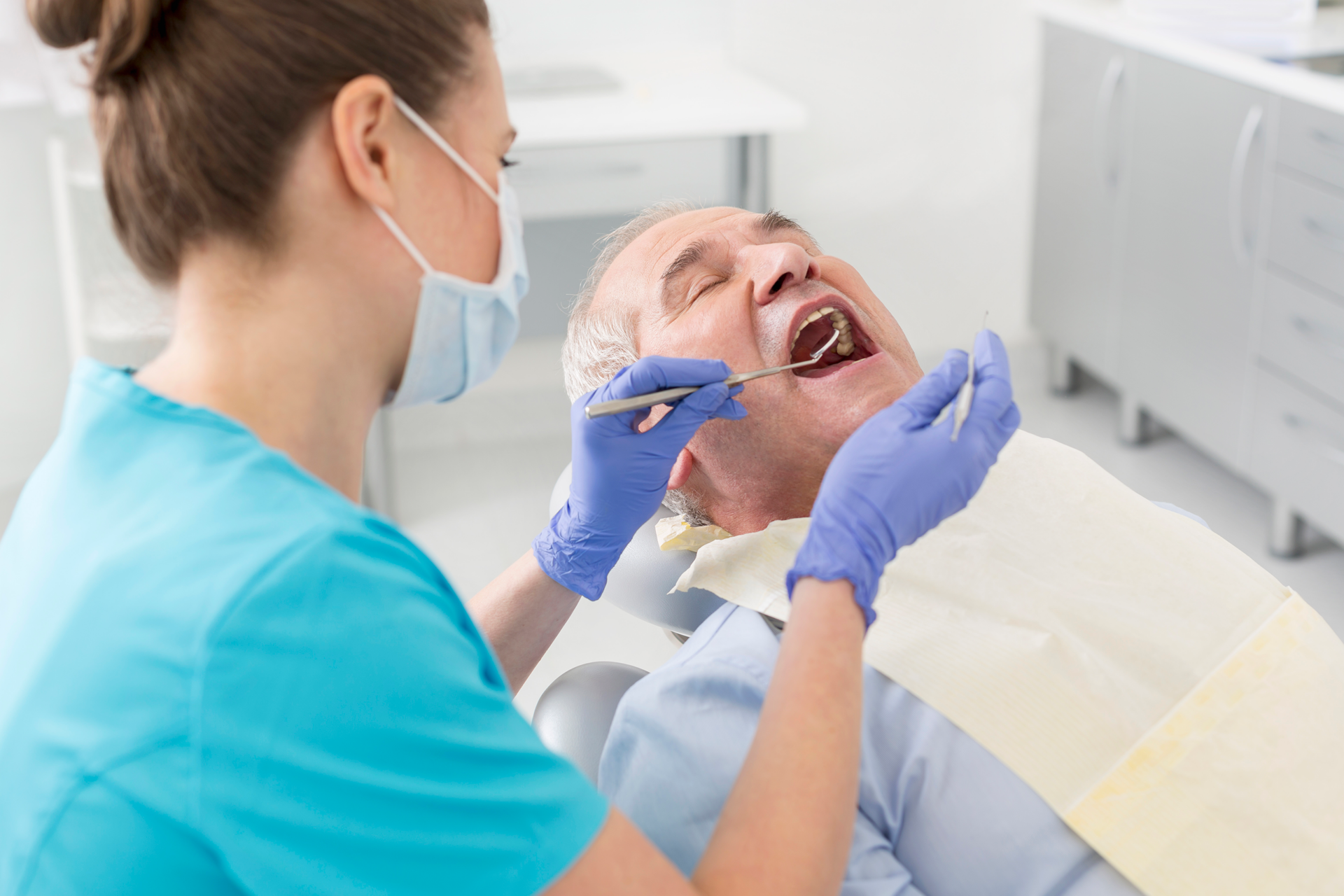Except in very limited circumstances, original Medicare doesn’t cover dental care.
Surgery to treat jaw fractures, some dental services to prepare for radiation treatment of oral cancer, or an oral exam in a hospital before a kidney transplant are among the few instances when Medicare will say OK. But original Medicare doesn’t cover any routine dental care or procedures, which many people don’t realize until retirement.
The percentage of people with dental coverage slopes downward dramatically at age 65 after they retire and lose employer coverage.
Among adults ages 50 to 64, a little more than a quarter lack dental insurance, according to the University of Michigan National Poll on Healthy Aging, that surveys about 2,000 people twice a year. When respondents reach 65 and beyond, Medicare age, the percentage of people without coverage increases to almost half, 47 percent.
One in 5 older adults polled said they had delayed getting dental care or have gone without it in the past two years. The majority said cost or lack of coverage played a role in that decision.
“Older adults have complex oral health needs. And either they don’t get the care they need, or they face high out-of-pocket costs trying to get the care they need,” says senior policy analyst Meredith Freed with the Kaiser Family Foundation’s program on Medicare policy, which published a report on Medicare and dental coverage in July 2021. The foundation found that 1 in 5 Medicare beneficiaries who used any dental services in 2018, the most recent year with information available, spent more than $1,000 out of pocket; 11 percent spent $2,000 or more.
A private Medicare Advantage plan or stand-alone dental policy may cover some of your dental needs, but the details can vary a lot. Some plans will pay only half the cost for extractions, fillings, root canals and major procedures.
Here are five things to know about Medicare and dental coverage and ways to help you cover the costs.
1. Medicare Advantage plans don’t have standardized dental coverage
In 2021, 94 percent of Medicare Advantage enrollees in individual plans had access to some dental coverage, according to the Kaiser Family Foundation. Only 10 percent of the Medicare Advantage enrollees are required to pay a separate premium to get dental benefits.
“Most plans cover preventive services, such as cleanings and X-rays, but the coverage of more extensive services definitely varies,” Freed says. The Kaiser study found that nearly two-thirds of enrollees in plans with access to oral exams, cleanings and X-rays do not get billed for these services.
Beyond preventive services, members usually have to pay a larger portion of the cost for crowns, dentures, extractions, implants, root canals and treatments for gum disease. The most common coinsurance amount Kaiser found was 50 percent for more extensive services. Cost-sharing ranged from 20 percent to 70 percent in the plans studied.
Coverage caps averaged $1,300 in 2021 but varied a lot. You may find higher limits if you shop around, but expect to pay higher premiums than for plans with lower limits, Freed says.
Fewer than a quarter of the people who had dental insurance were enrolled in a plan with an annual coverage cap of $2,000, the study found. About 1 in 12 were in a plan with an annual cap of $2,000 to $5,000.
Find out more about Medicare Advantage plans in your area by typing your zip code into the Medicare Plan Finder. You’ll see a green checkmark ✓ beside Dental if a plan includes dental coverage. Click the Plan Details button | Extra Benefits tab to see summaries of preventive and comprehensive dental coverage.
“If dental care is important to you, you need to look at the plan’s summary of benefits or evidence of coverage to see what the plan will cover as part of its dental package,” Freed says. Usually, this information is on a plan’s website.
A link to the Plan website is at the top of the Plan Details page. Some sites have phone numbers and chat features so you can talk to a customer service representative.
Since you can switch Medicare Advantage plans every year during open enrollment from Oct. 15 to Dec. 7 with coverage starting Jan. 1, check plans’ fine print even more carefully if you expect to have extensive dental work during the next calendar year. Consider that as one factor in your Medicare Advantage decision, along with coverage for your doctors, prescription drugs and health care needs. Some plans have dental provider networks, so make sure your dentist is included.
2. Stand-alone dental policies vary widely on details
Even though Medicare Advantage is the most common way for Medicare beneficiaries to get dental coverage after they retire, you have other options. If you would like to keep original Medicare or want to sign up for a dental policy in the middle of a year, you can buy separate insurance.
“Cost, benefit coverage, deductibles, waiting periods and annual maximums vary across the different types of dental plans by insurance carrier or provider, and by state,” says André Richards, spokesman for Delta Dental. The largest dental insurer of all ages in the United States sells individual and group dental plans.
Premiums for stand-alone dental policies vary based on coverage level and location. Policies generally don’t have preexisting condition exclusions but may require a waiting period before covering some expensive procedures, says Gregg Ratkovic, president of Medicare for insurance broker eHealth. They also generally have an annual coverage cap.
Stand-alone dental policies for people 65 and older generally cost $20 to $50 a month, Ratkovic says. These plans typically cover checkups and cleanings, but you’ll often pay 20 percent to 50 percent plus an annual deductible of $50 to $100 for work to restore teeth.
Be aware: Some plans, both stand-alone or part of a Medicare Advantage plan, might not pay to replace a tooth that was missing before your coverage started, according to the American Dental Association. Other dental problems that you had before you enrolled also might not be covered. That’s why it’s important to look at the details of a plan before you buy.
Find out if a plan you’re considering has a provider network, if your current dentist is included or if other in-network dentists are available in your area. Some plans cover out-of-network dentists, but you will pay more out of pocket.
3. Other options for dental coverage or discounts
First, look to your company or spouse’s employer if either of you is still working. Half the people 65 or older who had dental coverage were employees, spouses of employees or retirees, according to the National Poll on Healthy Aging. In some cases, employers may offer retirees access to a dental benefits plan or provide a referral to a company that offers benefits, says Richards of Delta Dental.
Second, you may be able to get dental coverage or a dental discount program through a Medigap policy. In 2020, about 1 in 8 Medicare beneficiaries were enrolled in Medigap plans with additional dental, vision or hearing benefits, according to the Commonwealth Fund, a century-old foundation that focuses on better health care. Some dental programs offer 30 percent to 40 percent discounts for services such as cleanings, crowns, exams and fillings using eligible dentists and have no copays, coverage limits or waiting periods.
Also:
- You can enroll in a stand-alone dental discount program, usually with an up-front annual fee.
- Ask your dentist if he or she participates in any other plans, such as in-house dental membership programs or discounts for up-front payments.
- Medicaid provides dental coverage in some states for people who meet income and asset requirements. About 1 in 9 Medicare beneficiaries had dental coverage through Medicaid in 2019, according to the Kaiser study. Fewer than half the states provide care beyond emergency dental services for adults. Contact your state Medicaid office for details.
4. Your dentist can be an ally to control expenses
Before you retire, talk with your dentist about the care that’s important to have in the next few years, says Leonard Brennan, a retired dentist and co-director of the Harvard School of Dental Medicine’s Geriatric Fellowship Program. If you need some expensive services, consider scheduling them while you still have dental coverage from your employer that could be better than your future coverage.
Don’t skip preventive dental visits such as teeth cleaning because you’re worried about the cost. The short-term savings could lead to larger health problems, Brennan says.
Your dentist may be able to stretch your coverage dollars. If you’re nearing your policy’s annual coverage cap, the dentist may be able to spread out some services you need into the next calendar year.
5. Tax-free HSA money can help with out-of-pocket dental costs
Even if you have dental coverage, you still may have a lot of costs you’ll have to pay for. If you already have a health savings account (HSA) because you had been receiving your health insurance through a high-deductible plan, you can withdraw money tax-free for eligible medical expenses, including dental costs.
You can’t make new contributions to an HSA after you enroll in Medicare. But you can withdraw money for eligible expenses at any age.
If you haven’t enrolled in Medicare yet, saving tax-free for medical and dental expenses is a good reason to start an HSA. To qualify to make HSA contributions in 2022, you must have an HSA-eligible health insurance policy with a deductible of at least $1,400 for single coverage or $2,800 for family coverage. You can contribute up to $3,650 for single coverage or $7,300 for family coverage in 2022, plus $1,000 in catch-up contributions if you’re 55 or older.
The HSA provides a triple tax break: Your contributions are taken out of your paycheck before taxes are calculated or they’re tax-deductible if not made through your employer. The money grows tax-deferred. And you can withdraw it tax-free for eligible expenses in any year.

